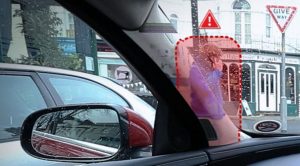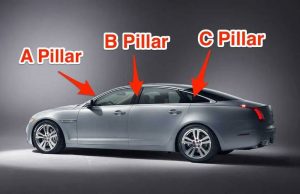
Windscreen pillars can obstruct your view of potential hazards when approaching bends and junctions in particular. Pedestrians, cyclists, and other vehicles can be hidden from view when turning and at road junctions. Different vehicles will have different blind spots caused by their design and the thickness of the windscreen pillars.
It is important to be aware of the blind spots caused by windscreen pillars, particularly if you are driving a model that you are not familiar with. You should also try moving your head and looking around the pillar to check there is nothing in the blind spot caused by it. You should also always double check your blind spots, particularly when approaching bends and at junctions.
What is a windscreen pillar?
Windscreen pillars refer to the vertical supports found on either side of your windscreen. They add extra support to the front of the vehicle and hold the windscreen in place. They are also sometimes known as ‘A’ pillars. Thicker pillars make it easier for designers to enhance safety. However, thicker pillars also increase issues for visibility and the likelihood of things being obscured from view. You should also take extra care for pedestrians and other potential hazards that may be obscured by your windscreen pillars, especially when approaching bends and junctions.

Theory Test Question
What answer would you give to this theory test question ‘when do windscreen pillars cause a serious obstruction to your view?’ Let’s consider each of the answers in turn to check your understanding.
When you’re driving on a motorway
Wrong! Motorways are usually very straight and open. However, you should be careful to check your blind spots when changing lanes.
When you’re approaching a one-way street
Wrong! Approaching a one-way street will not necessarily change the obstruction caused by your windscreen pillars unless you are turning into it.
When you’re approaching bends and junctions
Correct! Bends and junctions make it more likely that you will turn into a space obscured by your windscreen pillars. To avoid this, move your head to check the area you are moving into for potential hazards and always double check your blind spots.
When you’re driving on a dual carriageway
Wrong! Dual carriageways are usually very straight and open so your windscreen pillars will not usually pose a serious obstruction. However, be sure to check your blind spots when changing lanes or when approaching a junction.
References
Section 10 in the official DVSA guide to driving states:
Windscreen pillars can cause obstructions to your view of the road. You should be aware of this effect, particularly when
- approaching junctions and bends
- emerging from junctions.
Road users such as motorcyclists, cyclists and pedestrians may be completely obscured by the pillar.
You should be aware that some vehicles have larger blind spots than others,and groups of pedestrians, a motorcyclist or even a small car can be hidden from view. You may need to move around in your seat to overcome the effect of these blind spots.















